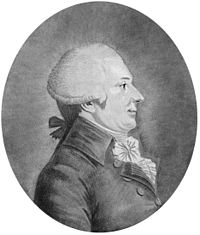Louis-Bernard Guyton de Morveau
| Louis-Bernard Guyton de Morveau | |
|---|---|

Louis-Bernard Guyton de Morveau
|
|
| Born | 4 January 1737 Dijon |
| Died |
2 January 1816 (aged 78) Paris |
| Nationality | French |
| Fields | chemistry |
| Known for | chemical nomenclature |
| Spouse | Claudine Picardet |
Louis-Bernard Guyton, Baron de Morveau (also Louis-Bernard Guyton-Morveau after the French Revolution; 4 January 1737 – 2 January 1816) was a French chemist and politician. He is credited with producing the first systematic method of chemical nomenclature.
Guyton de Morveau was born in Dijon, where he served as a lawyer, then avocat général, of the Dijon parlement.
In 1773, already interested in chemistry, he proposed use of "muriatic acid gas" for fumigation of buildings and as a result is sometimes given credit for having suggested chlorine in this use. However, chlorine was not well characterized at that time, and hydrogen chloride (made by reacting sodium chloride and sulfuric acid) was actually the active gaseous fumigation agent.
In 1782 he resigned this post to dedicate himself to chemistry, collaborating on the Encyclopédie Méthodique and working for industrial applications. He performed various useful services in this role, and founded La Société des Mines et Verreries in Saint-Bérain-sur-Dheune. He developed the first system of chemical nomenclature.
In 1783, he was elected a foreign member of the Royal Swedish Academy of Sciences and in 1788 a Fellow of the Royal Society.
During the Revolution, Guyton de Morveau (then styled Guyton-Morveau) served as Procureur général syndic of the Côte-d'Or département in 1790, was elected a deputy to the Legislative Assembly in 1792, and then to the National Convention.
...
Wikipedia
